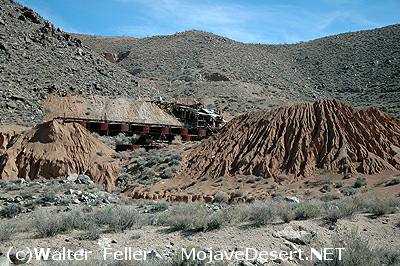San Bernardino County:
ARGUS-SLATE RANGE
John and Dennis Searles came from New York in the 1849 California gold rush and settled near Oroville. In the spring of
1860, Dennis Searles left with a party led by
Dr. Darwin French
to try to locate the Lost Gunsight Mine near
Death Valley. Needless
to say, they did not find the lost mine, but they did explore a lot of desert, and aroused the interest of the mining public. Not
long after returning from many months in the desert, Dennis Searles began making plans for a second expedition to the Mojave. On
this trip, Dennis took along his brother, John, and they investigated some gold and silver possibilities in the Slate Range. They
did discover silver and gold there, and a district was organized November 10, 1861, with Willet P. Dean, W. S. Morrow, A. H. Clarke,
and the Searles brothers the prime motivators. 27
The district was quiet until early 1863, when interest began to pick up and a 12 cabin camp called Constitution was established. The
Albany, owned by the Searles brothers was one of the first mines located and yielded $150 per ton in gold in a badly managed
arrastre. By February, 1863, a mill had been moved to the mine, and on July 20, a "large quantity of aqueduct lead pipe" left Los
Angeles for the mill at the Slate Range. 28
In the meantime, during the month of June, two shipments of 10 tons each left from the Antrium Lode. People were flocking to the
range. On one trip in from the mines, Dennis Searles met 13 inbound pack trains in one day. Earlier, in February, over 100 men had
left, "for the mines in the Slate Range and other desert areas by ones and twos since the arrival of the last steamer from San Francisco." In
spite of all this optimism, the Slate Range produced more mining companies than holes in the ground. Between March, 1863, and March, 1864,
the San Francisco Alta California recorded no less than 22 companies, incorporated for over $8,600,000, and there doubtless were
more. Chalfant puts the result this way: "The Slate Range system of working the public rather than the ledges began to produce natural
consequences. In one issue of the Visalia paper, August 7, 1863, were notices of assessments on eleven companies..." Things still
managed to hold out at some of the mines. In April, 1864, the Rochester Consolidated Gold and Silver Company shipped 200 pounds of
bullion. The mill was still running that October, but met a fiery death in November, 1866, when it was burned down by Indians in a
general uprising that vacated nearly all of the desert mining camps. 29
With the discovery of gold near the mouth of New York Canyon, men returned to the mines in the 1870s. George Hearst and associates
worked the Lone View and the San Francisco mines in the 1870s and 1880s, and the ore was milled at the Slate Range Millsite, perhaps
on the site of the first mill, located between Layton Canyon and New York Canyon. The Copper Queen Mine, later known as the Gold Bottom
Mine, is located northwest of Copper Queen Canyon. Located in the 1880s, this mine produced about a million dollars worth of silver-lead
ore before it shut down in 1943. Before World War II a twenty-five ton flotation mill was erected west of the mine. 30
The Ophir Mine was a late comer to the Slate Range, being opened in November, 1915. The mine produced about $800,000 worth of silver-lead
ore in operations between 1915 and 1950. In 1968 a 120-ton mill stood on the property. 31
In 1901 G. L. Dean acquired the Arondo gold mine across the valley in the Argus Range. The mine was actively worked by Dean until 1906,
with the ore hauled to the Slate Range Millsite, now known as Dean's Millsite. Various operators worked the mine until 1934, when the
Arondo Mines Company of Los Angeles took over the mine. This company installed a fifty ton mill and employed 10 men until 1937. Work
resumed, and the mine was active from 1939 until 1941, then from 1946 to 1950. 32
Homewood Canyon, south of the Arondo Mine is the site of two major mining operations. The largest of these is the Ruth Mine. It is
unclear when the Ruth Mine was first operated, but in the late 1930s the mine was under development by 10 men. At that time there was
a cyanide plant at the mine and a 700 foot tunnel with several hundred feet of additional underground workings. Work continued at the
mine until 1941 when operations were suspended by War Production Board Limitation Order L-208. About $550,000 worth of gold was
produced. Numerous people still live at this mine. Another major mining operation in Homewood Canyon was the Davenport Mine worked in the
late 1930s and early 1940s. Also, just south of Homewood Canyon, the Mohawk Mine was worked in 1941 and 1942 by the Burton brothers. The
Burton bothers also worked the Davenport and Ruth mines during this time. 33

Ruth Mine - Homewood Canyon